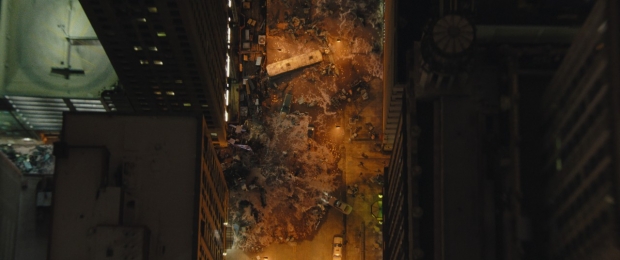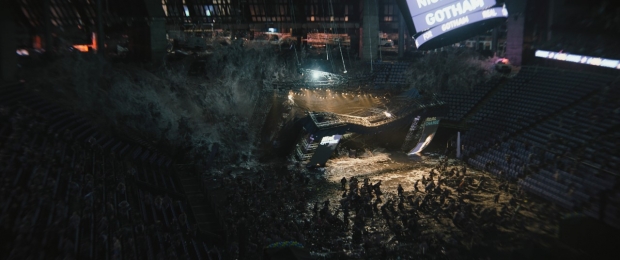Leading visual effects studio delivers 217 shots across 11 sequences in the DC thriller’s action-packed third act, including the destruction of seven dams and subsequent tsunami that engulfs Gotham Square Gardens.
Most of the visual effects you see in the third act of Warner Bros. and Matt Reeves’ new DC extravaganza, The Batman, were produced by Scanline VFX, who delivered 217 shots across 11 sequences. The studio’s work involved sequences where seven dams were blown apart by the Riddler (Paul Dano), unleashing a tsunami that rushes toward Gotham Square Gardens, as well as a burglary by Catwoman (Zoë Kravitz).
For the project, Scanline VFX produced high resolution digital doubles of Batman (Robert Pattison) and Catwoman. “For the Cat Burglary, there were digital doubles and fight enhancements on the plates to make sure that every punch connected,” remarks Julius Lechner, VFX Supervisor, Scanline VFX. “What I liked about the scene is we’re not cutting away. You see Zoë Kravitz throwing the punches. There were some takeovers with stunt doubles, and we had some face replacements as well.” Noting not too much environmental work had to be done, Lechner adds, “We did some small touch-ups.”
Substantial simulation work was needed because of the large volumes of water, architectural destruction, explosions, fire, smoke, and arcing electricity in the scenes. “A ton of reference of real tsunamis was studied to make sure it looked as real as possible but not too much over the top,” states Lechner. “We wanted the water and debris simulations to talk to each other; they also needed to be controllable so that the artists could creatively decide where we wanted the blockages and which direction the water would take but still felt like one coherent simulation. That was built as a low resolution-simulation to allow the artists to work faster. For the other things, like the glass and rigid body destruction, that was somewhat procedural, but we still wanted to art direct it as much as possible.”
Reeves (Let Me In) and production VFX Supervisor Dan Lemmon wanted the sense of danger to increase with the tsunamis. “If you look at actual footage [of a tsunami] people are not aware of how dangerous it is because you get a leading edge that is only about ankle height for quite a while,” explains Lechner. “Then within seconds it becomes this super dangerous churn of water. That was something we wanted to do as well. Also, a real tsunami is so full of debris, mud, and thick water that it becomes this viscous mass that moves through cities or terrain. What’s interesting is how light affects that because it’s so thick that when a car goes under the water you don’t see the headlights anymore.”
The destruction happens at night during Gotham City’s mayoral election. “We didn’t have to cheat much with the lighting,” Lechner shares. “However, it was hard to find references of tsunamis at night.” An interesting challenge was getting the correct colorization of the dense water when it traveled over patches of dirt and sewer openings. “We were able to define where to place the decolorization without having to re-simulate,” Lechner continues. “The debris assisted with conveying size and scale. Having some that is recognizable to viewers gives you scale, such as a car. But we always try to be as close to real world [as possible] when it comes to spray and mist particles. We go to a very detailed level, which makes the simulations incredibly heavy.”
Practical explosions were produced onset by Special Effects Supervisor Dominic Tuohy (1917). “There was a partially built set that we extended and replaced some portions of for the storyline,” Lechner remarks. “Then we used parts of the real explosion and made them bigger. The fireball was real and most of the interaction with the environment was replaced. There is still some real footage that was combined with the CG explosion which always works great. Because this occurs at night, we had all the interactive lighting from the fire into the water and smoke. Also, when the water goes over the fire, the fire extinguishes and leaves behind the smoke.” For the seawall explosion, Lechner says, “it was important to have shockwaves kicked up environmental dust and dirt.”
Glass was factor, especially when the Gotham Square Gardens roof comes crashing down. “Glass always leads to high render times because you get all of these pings, reflections, and refractions,” Lechner describes. “It was dirty as well as since Gotham is old and dirty.” The arcing electricity between the disconnected cables and rafter beams required significant art direction. “We had to find a balance of making it look exciting but also understandable,” the VFX supervisor reveals. “If you do too little it won’t look dangerous. If you do too much, then it’s too much for the viewer to take in within such a short amount of time. The bright flashes of electricity helped to convey that this is dangerous.”
For the ground section of Gotham Square Gardens, footage was shot at O2 Arena in London. Cameras were also placed in the rafters by cinematographer Greig Fraser (Dune) to capture lighting and lensing references. “An entirely CG arena was built so the camera could be put anywhere we wanted,” states Lechner. “But the lower section was based on the O2 Arena with the entrance changed to fit with what was onset and the story. The architecture of the arena was changed to suit the action that happens in the sequence. The real footage from the rafters was lit nicely and a great reference for the full CG backgrounds.”
Fraser put caulking on a piece of glass that was placed in front of the camera to create spiderweb-like lens flares. “I liked the lenses that Greig used on the film,” notes Lechner. “It was a challenge to reproduce those effects in CG. We had to come up with an entirely new setup to match them.” Some crowd plates were used in shots, while others served as good reference. “There was a lot of CG crowds in the arena in order to be able to understand the panic. We built a bunch of different characters and varied them up in terms of their clothing. What’s interesting about crowd simulations is you don’t usually get to focus on a single person because there’s too much going on, but you definitely understand what the mass of people are doing. They need to be smart and always have a purpose.”
Modifications were made to Scanline VFX’s pipeline to achieve the believable detail required on the CG build of Gotham Square Gardens. “We had to change the way assets are loaded and the way that we work with them on the animation side,” Lechner states. “We also had to alter the way the assets are loaded for rendering to be able handle the volume and make them more workable. Our water setup was slightly changed, which happens with every show that involves water because we always learn something.”
Before The Batman, the visual effects supervisor worked on Batman v Superman: Dawn of Justice and Zack Snyder’s Justice League. “I like working on both variations of Batman. With every project you have to adapt to the style of the people you are collaborating with and the director. I really enjoyed working with Dan, who was always clear about exactly what he wanted. The biggest challenge was to make sure that visual effects fit seamlessly in the movie, which affected so many departments, like the asset build, shaders, lighting, and simulations. I’m incredibly proud of the work that we did. It was a great experience for me and the team.”











